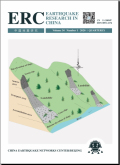- 钛学术文献服务平台 \
- 学术期刊 \
- 基础科学期刊 \
- 天文学、地球科学期刊 \
- 中国地震研究(英文版)期刊 \
Dynamic Response of Shallow-Buried Tunnels Traversing High Loess Slopes
Dynamic Response of Shallow-Buried Tunnels Traversing High Loess Slopes
基本信息来源于合作网站,原文需代理用户跳转至来源网站获取
摘要:
Considering the existence of numerous shallow-buried tunnels traversing high slopes in the loess area in western China and the fact of high seismic intensity there, we investigate the dynamic response rules of a shallow-buried loess tunnel and its slope under the action of seismic waves with different intensities. Through large-scale shaking table model tests, we successfully analyze the characteristics and process of the destabilization of tunnels and slopes, and propose valuable suggestions regarding the reinforcement parts of a tunnel for reducing seismic damage. The results show that the main seismic damage on a slope include the failure of the sliding surface between the top and foot and the stripping of the soil around the tunnel entrance, while the damage on a tunnel is mainly manifested as the seismic-induced subsidence at the portal section and the cracking deformation at the joint areas. Finally,we propose that the"staggered peak distribution"phenomenon of the maximum acceleration values at the vault and inverted arch area can be considered as a criterion indicating that the tunnel enters into the threshold of dynamic failure.

推荐文章
Geological cycling of potassium and the K isotopic response: insights from loess and shales
K isotopes
Loess
Shale
K cycle
Using electrogeochemical approach to explore buried gold deposits in an alpine meadow-covered area
Electrogeochemistry
Buried mineral deposit
Ideal anomaly model
Alpine-meadow covered
Ihunze
Dated deposition couplets link catchment erosion flux with storm discharge on the Chinese Loess Plat
Landslide-dammed reservoir on the CLP
Deposition couplet
XRF core scanning
137Cs activity
Erosion flux
Characteristics of CO2 in unsaturated zone (~90 m) of loess tableland, Northwest China
Unsaturated zone
Soil CO2
Carbon stock in deep loess
Quantitative paleoclimate reconstruction
Loess
内容分析
关键词云
关键词热度
相关文献总数
(/次)
(/年)
文献信息
| 篇名 | Dynamic Response of Shallow-Buried Tunnels Traversing High Loess Slopes | ||
| 来源期刊 | 中国地震研究(英文版) | 学科 | |
| 关键词 | |||
| 年,卷(期) | 2020,(4) | 所属期刊栏目 | Landslide Mechanism |
| 研究方向 | 页码范围 | 496-509 | |
| 页数 | 14页 | 分类号 | |
| 字数 | 语种 | 英文 | |
| DOI | 10.19743/j.cnki.0891-4176.202004006 | ||
五维指标
引文网络
引文网络
二级参考文献 (136)
共引文献 (292)
参考文献 (14)
节点文献
引证文献 (0)
同被引文献 (0)
二级引证文献 (0)
1991(2)
- 参考文献(0)
- 二级参考文献(2)
1992(1)
- 参考文献(0)
- 二级参考文献(1)
1994(1)
- 参考文献(0)
- 二级参考文献(1)
1996(1)
- 参考文献(0)
- 二级参考文献(1)
1997(1)
- 参考文献(0)
- 二级参考文献(1)
1998(3)
- 参考文献(0)
- 二级参考文献(3)
2001(6)
- 参考文献(2)
- 二级参考文献(4)
2002(1)
- 参考文献(0)
- 二级参考文献(1)
2003(4)
- 参考文献(0)
- 二级参考文献(4)
2004(4)
- 参考文献(0)
- 二级参考文献(4)
2005(5)
- 参考文献(0)
- 二级参考文献(5)
2006(12)
- 参考文献(0)
- 二级参考文献(12)
2007(5)
- 参考文献(0)
- 二级参考文献(5)
2008(9)
- 参考文献(2)
- 二级参考文献(7)
2009(13)
- 参考文献(2)
- 二级参考文献(11)
2010(11)
- 参考文献(0)
- 二级参考文献(11)
2011(8)
- 参考文献(1)
- 二级参考文献(7)
2012(10)
- 参考文献(0)
- 二级参考文献(10)
2013(10)
- 参考文献(0)
- 二级参考文献(10)
2014(16)
- 参考文献(1)
- 二级参考文献(15)
2015(10)
- 参考文献(0)
- 二级参考文献(10)
2016(9)
- 参考文献(3)
- 二级参考文献(6)
2017(5)
- 参考文献(0)
- 二级参考文献(5)
2018(1)
- 参考文献(1)
- 二级参考文献(0)
2019(2)
- 参考文献(2)
- 二级参考文献(0)
2020(0)
- 参考文献(0)
- 二级参考文献(0)
- 引证文献(0)
- 二级引证文献(0)
引文网络交叉学科
相关学者/机构
期刊影响力
中国地震研究(英文版)
主办单位:
中国地震局
出版周期:
季刊
ISSN:
0891-4176
CN:
11-2009/P
开本:
16开
出版地:
北京西城三里河路56号
邮发代号:
创刊时间:
1987
语种:
eng
出版文献量(篇)
971
总下载数(次)
0
总被引数(次)
373
期刊文献
相关文献
推荐文献
- 期刊分类
- 期刊(年)
- 期刊(期)
- 期刊推荐
力学
化学
地球物理学
地质学
基础科学综合
大学学报
天文学
天文学、地球科学
数学
气象学
海洋学
物理学
生物学
生物科学
自然地理学和测绘学
自然科学总论
自然科学理论与方法
资源科学
非线性科学与系统科学
中国地震研究(英文版)2022
中国地震研究(英文版)2021
中国地震研究(英文版)2020
中国地震研究(英文版)2019
中国地震研究(英文版)2018
中国地震研究(英文版)2017
中国地震研究(英文版)2016
中国地震研究(英文版)2015
中国地震研究(英文版)2014
中国地震研究(英文版)2013
中国地震研究(英文版)2012
中国地震研究(英文版)2011
中国地震研究(英文版)2010
中国地震研究(英文版)2009
中国地震研究(英文版)2008
中国地震研究(英文版)2007
中国地震研究(英文版)2006
中国地震研究(英文版)2005
中国地震研究(英文版)2004
中国地震研究(英文版)2003
中国地震研究(英文版)2002
中国地震研究(英文版)2001
中国地震研究(英文版)2000

 免费查重
免费查重










